Section 19. Snoqualmie Pass to Stevens Pass

Section 19. Snoqualmie Pass to Stevens Pass. 22-25 September. I left late at around 9 lingering in the comfort of probably the last hotel on the trail. After a short walk on the verge the trail started to climb up the east side of Snoqualmie Pass, zigzagging up through large conifers and perhaps the biggest hemlocks of the trail so far. The path was quite busy with day trippers even though it was Friday. I chatted with many of them, as it seemed hikers in Washington were the friendliest and also the most dedicated hikers on the trail so far.
The trail climbed relentlessly for a good 2 hours slowly gaining on the peaks I could occasionally see through the trees until it go to a saddle. The saddle was sensational as the path along it was blasted out of a rock slab, with a huge fall down the west side. Once I was over the traverse I looked around and saw steep mountains covered in dusting of snow in every direction. It was a fantastic view despite the low clouds and occasional mists. Washington was living up to expectations.

01. My first view of the North Cascades at the top of the climb up from Snoqualmie Pass.
The path then went across steep hillsides with mountain hemlock clinging to their flanks for a good 8 miles to reach Chikamin Saddle. These 8 miles were superb with high alpine lakes nestled into high rocky cirques. There were plenty of scree slopes and on them Pika scurried around with mouthfuls of grass to take into their rocky burrows to help them feed through the winter. There were also some marmot and and they were a different species to the Yellow Bellied Marmots of the Sierra. These were Hoary Marmots. From here I hiked with a lovely group of 3 for a couple of miles. One of the ladies, Tannie, had also written a couple of guidebooks on this area and knew all the flora and fauna. We chatted a lot but they went on when I stopped to put on waterproofs.

03. The Hoary Marmot occupied the scree fields, sharing them with the Pika. Marmots hibernate while Pika survive off stored fodder.
The path was quite arduous with frequent climbs and descents across rocky terrain on steep hillsides but the dramatic alpine views were wonderful. There was up to 6 inches of snow of some sections of the path and one had to be careful not to slip as it was steep. The colours of the shrubs and berry bushes were orange and red and it looked like parts of the hillside were ablaze, especially beside the snow or green hemlocks.
As I approached the Chikamin Pass it started to rain and the swirling mists thickened. The next 2 hours were a bit miserable but the drama and atmospheric views continued over the pass and down the twin Park Lakes. It was getting cold and miserable now and with dusk approaching I decided to camp her. Just then the cheerful Dixie appeared. She was a well known character on the PCT and I had met her twice before in the desert and Sierra. She was renowned for two things, firstly having a YouTube channel about her hikes with over 60,000 followers and secondly for having walked 62 miles in 24 hours. We found a spot for 2 tents beneath some hemlock near a pond and put up the tents in the drizzle and dusk fell.
I got up and was away by 8, while Dixie was packing up and having her coffee. It was a much nicer day but still a bit overcast with the sharp peaks in the mist. Just beyond the ponds in the Park Lakes vicinity the path started a long descent to Spectacle Lake, with its multiple promontories and bays, and then continued past a lovely waterfall and on down many zig-zags into the Lemah Valley. It was a drop of 2000 feet all together.
By now the weather had cleared up and the peaks were unveiled from the mists. They were very impressive and I was surrounded by them on all sides. However to the west they were the most alpine with small glaciers and sharp summits covered in a dusting of newer snow. The North Cascades were a truly alpine range. Below the peaks were ridges and cirques of hemlock and fir and then glades of orange and red maple scrub.
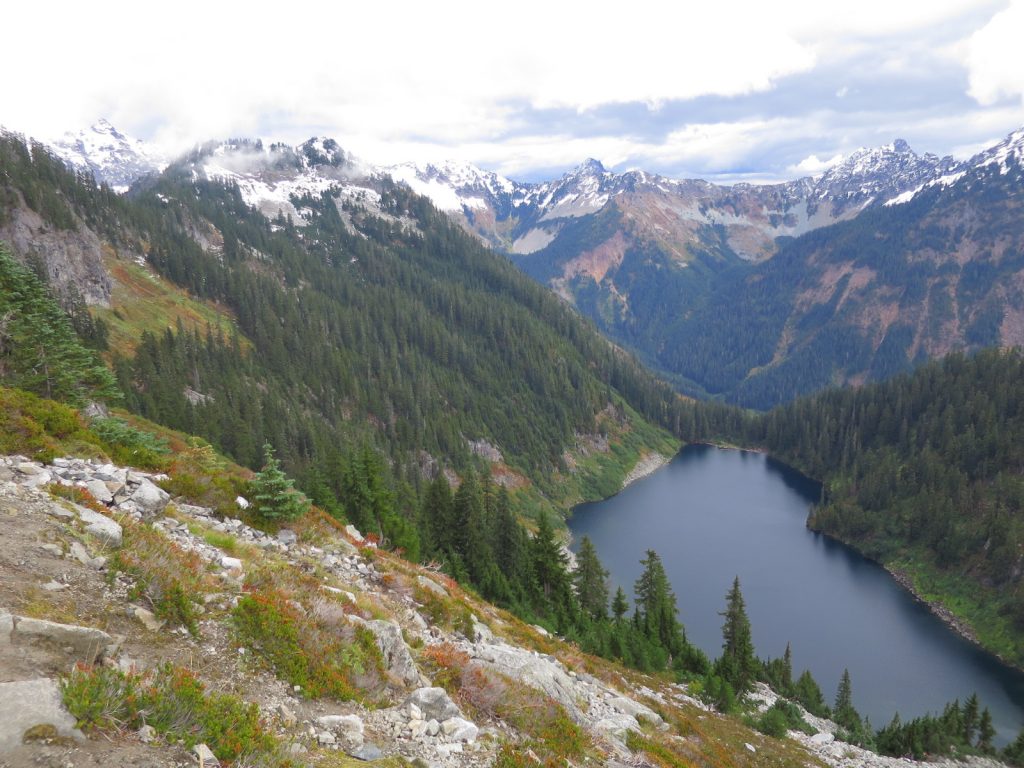
04. Alaska Lake with some typical North Cascades peaks in the background.
I now had a long near 3000 foot climb north out of the valley. I felt good and powered up the whole thing without stopping in about 2 hours. My legs of steel working automatically and without much effort. As I climbed more and more peaks appeared revealing a true grand and dramatic landscape.
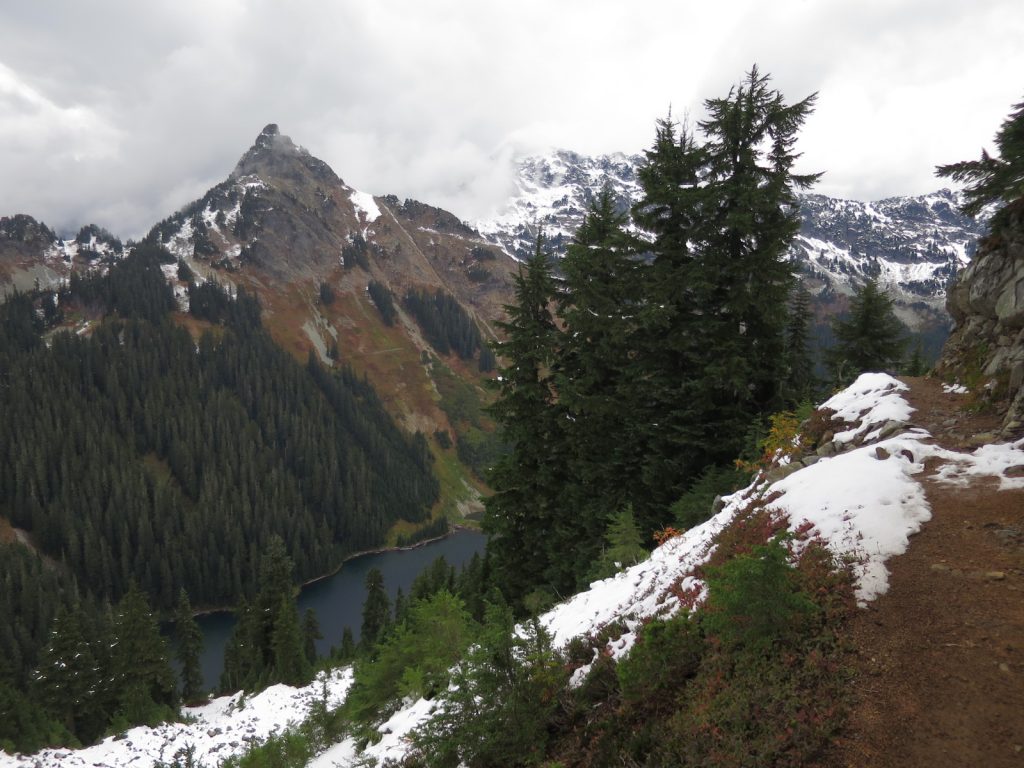
05. Crossing the ridge on Alaska Mountain with Joe Lake nestled in its deep forest clad cirque.
As the top was a small lake where I rested in a heather and berry glade. The sun warmed me as I lay on the heather eating lunch. Chipmunks scurried around eating cranberries which were abundant. They would pluck one and then stand on their hind legs while nibbling on the berry which they held in their front paws. I am not sure if chipmunks hibernate or survive in the subnival layer between the snow and heather. There would be plenty of berries buried in the snow for them to eke out the winter.
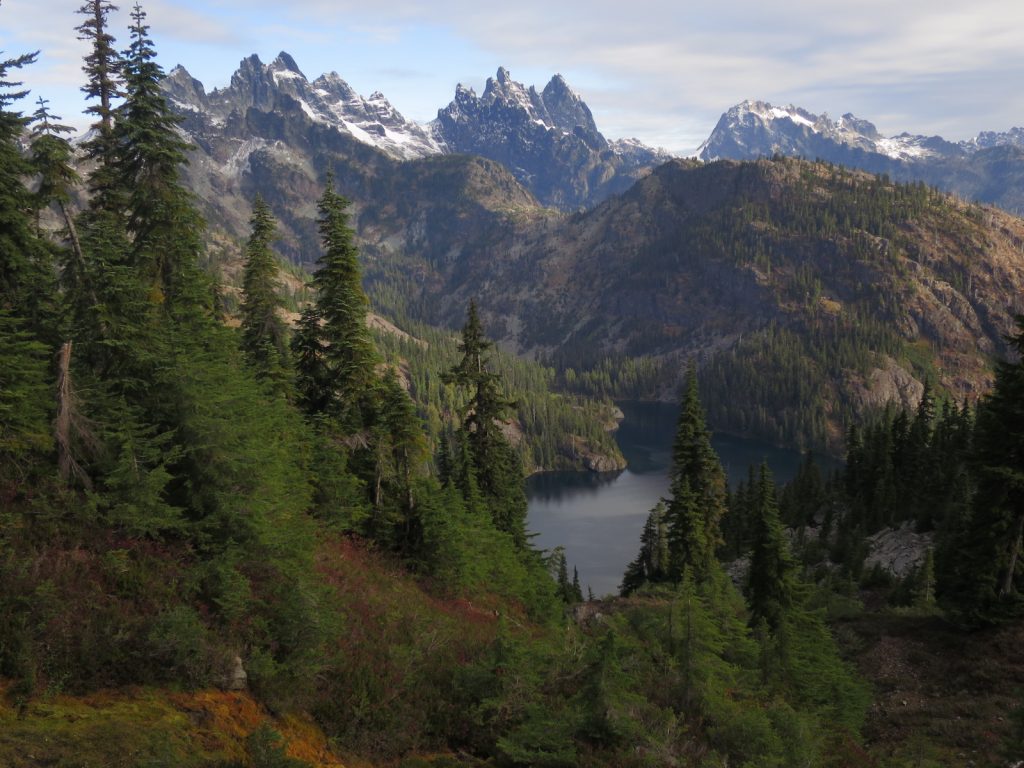
07. Looking down onto Spectacle Lake with some peaks in the Alpine Lakes Wilderness of the North Cascades.
After my leisurely lunch I started the long descent to the Waptus Valley with its relatively large lake. Soon I was into the hemlocks again which steadily got bigger. I saw a hare on the path as I went down it, and also a lot of grouse, but I was not sure what species but got some photos. The maple scrub was turning into rich colours but were still not full orange. It was not prime time for leaf watchers just yet.

08. The rich shades of the shrub maple were getting more spectacular every day as autumn progressed.
Just as I reached the Waptus Creek Dixie appeared. We both agreed it had been a fabulous day with great scenery. A day like this can almost leave you euphoric. It was a great privilege to be fit enough to walk in this mountain range and appreciate it.
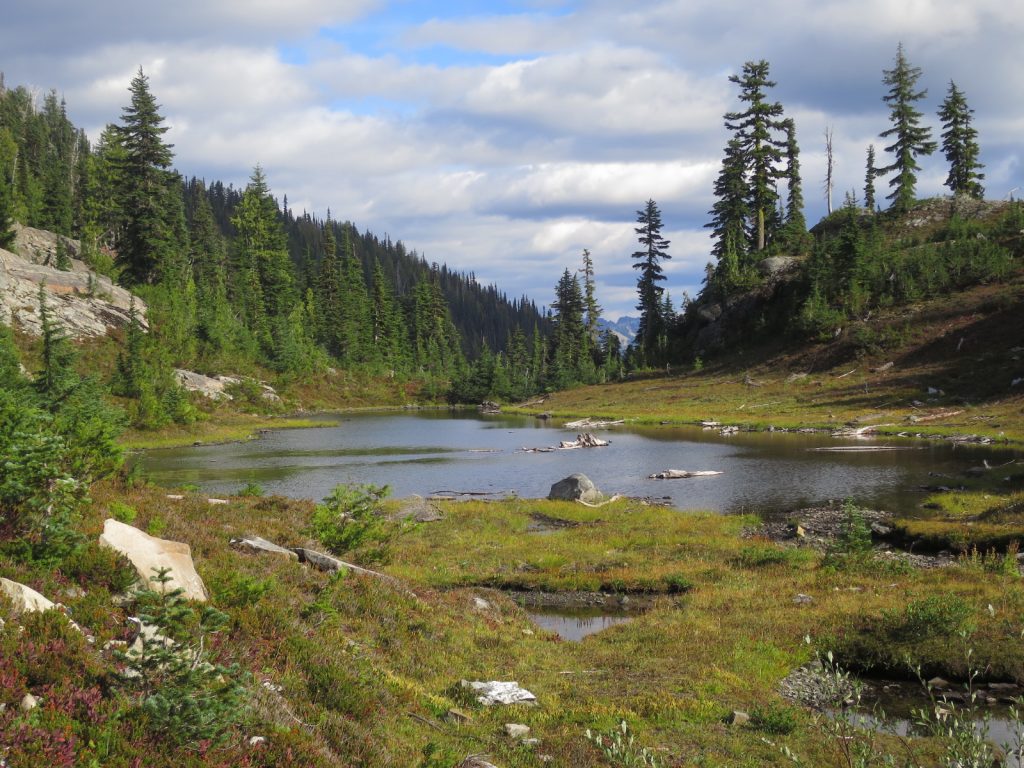
10. The small lake were I could relax and enjoy a lunch in the warm sun before the descent to Waptus Lake.
Dixie and myself agreed on a campsite in 3 miles and we set off for it chatting about the glorious area. We crossed the Waptus Creek and the headed east through the forest on the north shore of Waptus Lake. Half way along the head torches came out as it was dark in the forest now by 1930. When we got to the campsite there were already 2 other tents there, but were managed to squeeze another two in. By the time the tent was up I noticed that the place was home to about 5 brazen mice who were not afraid of humans. There scurried all over the place and even up and down the mesh of the tent door.
In the morning the brazen mice were the talk of the camp. Dixie had managed to get some great videos of them hopping onto her cooking pot lid while she was cooking. I left about 8 and started up the gentle Spinola Creek Valley to the north. It climbed gently through the hemlocks for 4 miles to reach Deep Lake. It was a beautiful day with blue skies but there was little view through the thick forest. However there were some beautiful glades where a shafts of light illuminated the yellow, orange, and crimson leaves of the understorey.
I stopped for breakfast at Deep Lake. It was a calm lake surrounded by high jagged peaks many with snow on the upper slopes from the cold front nearly a week ago. Around the shore of the shoreline of the lake were grassy meadows, golden in their autumnal colours, and drifts of huckleberry bushes bright red in the sun. It was a picture postcard setting. As I ate Dixie appeared and crossed on the stepping stones across the lake’s outlet. I had just seen a chipmunk do the same but it had to leap from stone to stone.
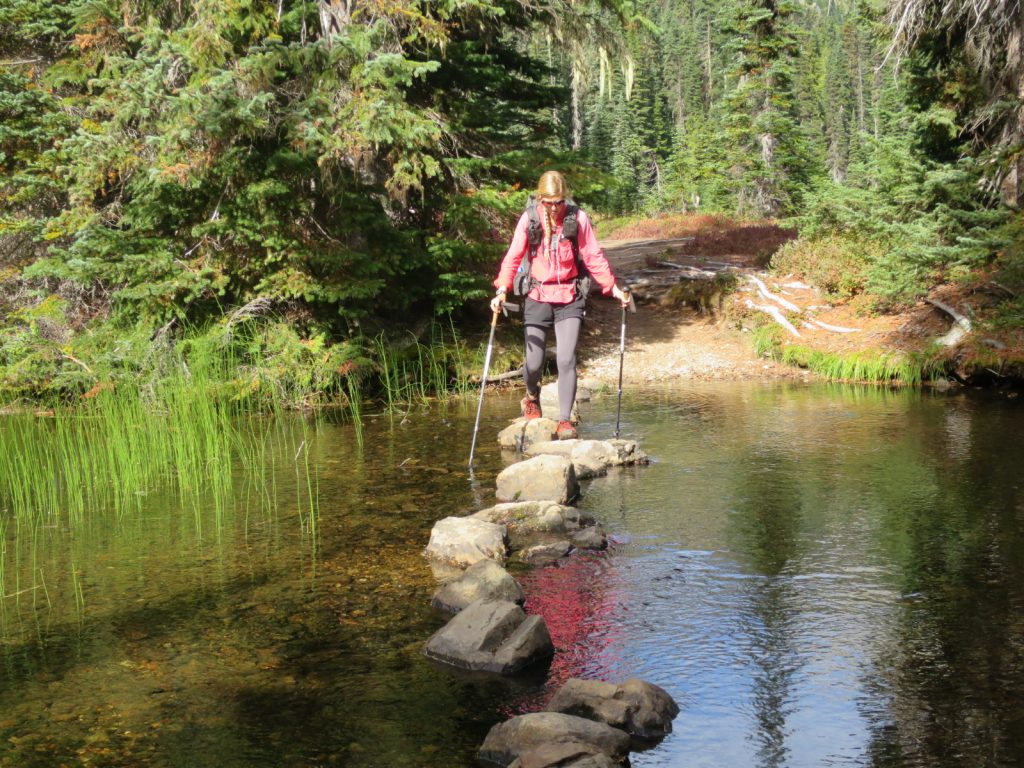
11. Dixie crossing the stepping stones at the outlet of Deep Lake.
After breakfast I continued up the path which climbed in zig-zags up the east side of Deep Lake to the rocky spire of Cathedral Rock. As i climbed the views got better and better. The North Cascades were much more rugged than I thought and there were ridge upon ridge of sharp glaciated mountains in every direction. The Cascades were full of grandeur and at this time of year colour also. The trees were still mainly hemlock but there were firs and the graceful western red cedar with its drooping branches.

12. A sample of the vibrant autumn colours by the outlet of Deep Lake. The crimson is largely the huckleberry bushes.
From the top of the climb by Cathedral Rock the path now descended for 5 miles keeping high above the Hyas Lakes, which were seldom visible due to the trees. It then started yet another sustained climb for a 5 miles up to Piper Pass. Once out of the hemlocks mountain views opened opened up again with new glaciated peaks appearing. Half way up the climb I passed the beautiful Deception Lakes before the final ascent. As I climbed there were more and more boulder fields and scree slopes and these were rife with Pika. Their amusing squeaks warning others I was about. They were like small marmots but much cuter on account of their big ears.

13. Looking back down to Deep Lake from the pass to the east of it by Cathedral Rock.
From Piper Pass there was a short steep rocky descent down the path covered in snow to Glacier Lake. Dusk was approaching and the comfortable warm temperature of the day was vanishing and I could feel my hands getting cold out of the sun. At the bottom of the descent I reached a small stream and a camp spot and called it a day. Everyone else had gone on so I had it to myself. I had really enjoyed myself today walking through this fantastic scenery with the vibrant autumn colours. It had been a joy from dawn to dusk.
There was some light drizzle when I woke which surprised me as I was not expecting any. I got up and packed my stuff under the dripping trees and headed off by 7.30. It was more of a mist than drizzle and it soon cleared leaving overcast skies. I expected to see Dixie at the campsite on the first pass as she was a slow starter but she was already away and I had little chance of catching her with my careful deliberate pace. The descent down the north side of the pass to Trap Lake was gorgeous with grand views down the autumnal valley to distant ranges.
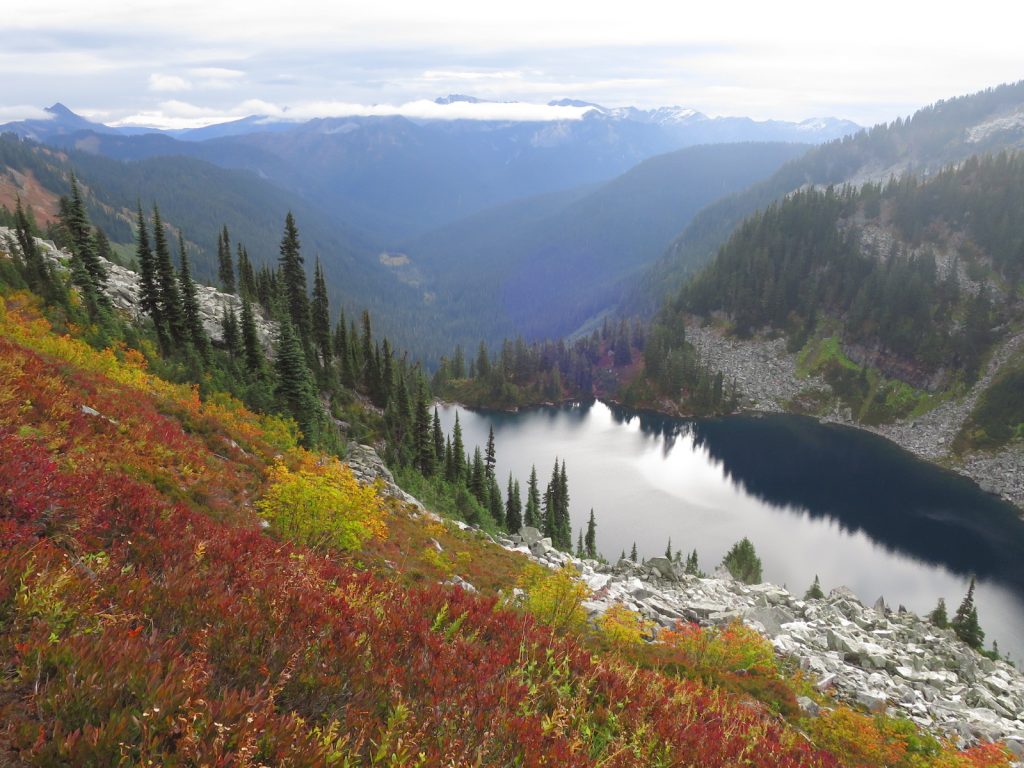
14. Looking down onto Trap Lake with the mist clearing from the pass with a superb campsite.
The path now remained quite level as it traversed across the hillside over a spur and down to two stunning lakes surrounded by crimson berry bushes and yellow grasses. These vibrant colours were highlighted by the dark green backdrop of the hemlocks and firs. I paused at both lakes as the thin mist came and went and trout snatched flies from the surface. Both Hope and Mig Lakes were a perfect poetry of nature with their evocative atmosphere.

15. The serene, idyllic Mig Lake with its water lillies and fringe of Huckleberry bushes.
I continued north over a couple of smaller passes and past a few more lakes as the mist returned. This time it was heavier and I had to stop to put waterproofs on me and the rucksack when it turned into a drizzle. Even with the poor weather there was plenty to inspire me; pikas running around with mouthfuls of grass and leaves stocking there subterranean larder before the winter, grouse which sat on the trail looking at me in a bemused manner, and the stunning colours of the mountain ash and huckleberry leaves.

16. Plump, sweet huckleberries undiscovered by bear, chipmunks or birds so far. Yours for the picking!
As I neared Stevens Pass I went under some pylons and past by some ski lifts before the final descent to the ski lodges. One of them Tye Creek Lodge, had my last resupply package with all the food for the final 200 miles which would hopefully take 10 days weather permitting.
I had also learnt, to my unrestrained joy, there was the Mountaineers Lodge which was open for about 6 weeks in the autumn to cater for the steady trickle of PCT hikers. It was an old building with rustic toilets on the ground floor, a wooden lined lounge with bench tables, a kitchen and a roaring fire on the first floor, and 2 large dormitories on the second floor in the attic space. There was just myself and 3 other hikers, here plus the volunteer hosts. After my shower it gave me great pleasure to sit beside the fire and watch the rain fall outside. This warm cosy shelter was a great surprise.